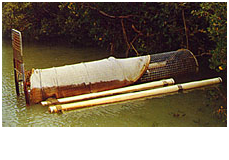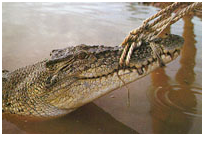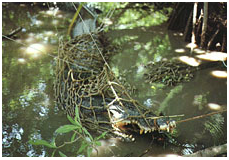CCBM Section 55. FIELD TECHNIQUES 5.1 Survey methods (Michael Cherkiss and Alvaro Velasco) With few exceptions, crocodilians must be located and counted for studies of their ecology or in the development of a management plan (Bayliss 1987). Various techniques are used for finding and counting crocodilians and depend on a variety of factors such as habitat type, cost, field logistics, goal of the study, etc. Cherkiss et al. (2009) provide a good overview of transportation needs and crocodilian survey methods and drawbacks, which include: Transportation Automobile: work well when surveying a canal or water body adjacent to a road or raised levee.All-terrain amphibious: used to traverse large expenses of dry areas between wet ones, when seasonal wetlands dry out periodically leaving crocodilians concentrated in isolated ponds and pools.Walking: Sometimes crocodilians can be found on foot. Horseback: is a method used in the Venezuelan Llanos to visit caiman ponds. Water-craft: usually have a shallow draft and open interior and include Kayaks, jon boats, canoes, pirogues, marsh skiffs, fishing skiffs of various design, and airboats. Fixed-wing aircraft and helicopters: Can be used to find crocodilians in areas not accessible by boat, and to cover large areas quickly. Survey Methods Informants:can be helpful upon the initial visit to a site as a method to obtain background information or in determining current needs (Thorbjarnarson 1988; Thorbjarnarson and Hernandez 1988). Artifacts: Searching a site for the sign (crawls, nesting sites, etc.) of a crocodilian can be helpful in determining the presence (but not absence) of animals. Daylight Ground Counts: Daylight ground counts require the least equipment and are the most easily arranged. However, many zero-counts have been associated with daylight ground counts, given that crocodilians refrain from basking with cloudy weather or when the optimal body temperature is reached (O'Brien 1990). These counts can be done on foot, from a ground vehicle, or from the air, sometimes reducing transportation and logistical costs (Magnusson 1982). Daytime Aerial Surveys: are widely accepted as a cost-effective method to survey crocodilian habitat given the immense ground coverage in a limited time (Magnusson 1982; O'Brien 1990). Aerial surveys are most effective in open marsh and lake habitats to detect distribution and abundance of crocodilians or nests, and least effective in areas where canopy closure blocks visibility (Magnusson 1982; O'Brien 1990). Night Spotlight Survey: are the preferred method of crocodilian survey (Magnusson 1982) due to their versatility in habitat and the nocturnal nature of the animals. Spotlighting is usually performed from a watercraft but can be done on land from a vehicle or on foot. Eyeshines allow the researcher to see the animal from great distances and in situations where the animal might not have been otherwise seen (O'Brien 1990). Night surveys may be the most costly ground effort but produce the most reliable population data. This technique also allows for gathering environmental data and specific details on the animal and its condition.Lighting: Good lights make a big difference. Brighter is not always better; very bright lights will wash out the eyeshine from smaller crocodilians and those that are nearby. Lights in the 50,000 to 200,000 candlepower range are most effective (Cherkiss et al. 2009). Limitations Factors other than population density affect the number of crocodilians counted during a survey, and not all of the crocodilians in an area will be counted (Graham and Bell 1969; Magnusson et al. 1978; Bayliss 1987).Environmental conditions (wind, air and water temperature, and wave action) impact survey results and ability to observe animals (Woodward and Marion 1979).Two observers shining lights independently can estimate potentially visible crocodilians missed (when one observer sees one that the other does not) during surveys (Magnusson et al. 1978; Bayliss 1987). Wariness of crocodilians is another factor affecting results and can be estimated by the distance an observer can approach before submergence (Webb and Messel 1979; Pacheco 1996), and visibility in different habitats can be tested by thoroughly searching a sample area in daylight after a typical survey, or by having one crew set out dummy crocodilians to be counted by a survey crew (Cherkiss et al. 2006, 2009). References Bayliss, P. (1987). Survey methods and monitoring within crocodile management programmes. Pp. 157-175 in Wildlife Management: Crocodiles and Alligators, ed. by G.J.W. Webb, S.C. Manolis and P.J. Whitehead. Surrey Beatty and Sons: Chipping Norton, NSW. Cherkiss, M.S., Mazzotti, F.J. and Rice, K.G. (2006). Effects of shoreline vegetation on visibility of American Crocodiles (Crocodylus acutus) during spotlight surveys. Herpetological Review 37(1): 37-40. Cherkiss, M.S., Fling, H.E., Mazzotti, F.J. and Rice, K.G. (2009). Counting and capturing crocodilians. CIR1451, IFAS Extension, University of Florida. Graham, A., and Bell, R. (1969). Factors influencing the countability of animals. East African Agricultural and Forestry Journal 34(Special Issue): 38-43. Magnusson, W.E., Caughley, G.J. and Grigg, G.C. (1978). A double-survey estimate of population size from incomplete counts. Journal of Wildlife Management 42: 174-176. Magnusson, W.E. (1982. Techniques of surveying for crocodilians. Pp. 389-403 in Crocodiles. Proceedings of the 5th Working Meeting of the IUCN-SSC Crocodile Specialist Group. IUCN: Gland, Switzerland. O'Brien, T. (1990). A comparison of 3 survey methods for estimating relative abundance of rare crocodilians. Pp. 91-108 in Crocodiles. Proceedings of the 10th Working Meeting of the IUCN-SSC Crocodile Specialist Group. IUCN: Gland, Switzerland. Pacheco, L.F. (1996). Wariness of caiman populations and its effect on abundance estimates. Journal of Herpetology 30: 123-126. Thorbjarnarson, J.B. (1988). The status and ecology of the American crocodile in Haiti. Bulletin of the Florida State Museum Biological Sciences 33(1). Thorbjarnarson, J.B. and Hernandez, G. (1988). Recent investigations into the status of Orinoco crocodiles in Venezuela. Pp. 308-328 in Crocodiles. Proceedings of the 9th Working Meeting of the IUCN-SSC Crocodile Specialist Group. IUCN: Gland, Switzerland. Webb, G.J.W. and Messel, H. (1979). Wariness in Crocodylus porosus. Australian Wildlife Research 6: 227-234. Woodward, A.R. and Marion, W.R. (1979). An evaluation of factors affecting night-light counts of alligators. Proceedings of the Annual Conference of the Southeast Game and Fish Commission 32: 291-302. 5.2. Population estimation, monitoring and trend analysis 5.3. Handling Crocodilians (Michael Cherkiss) Animals that are captured, processed and released quickly show little ill effect from their experience. Cherkiss et al. (2009) briefly describe handling techniques, which will be discussed and expanded upon here. Safe handling techniques are similar whether you are catching from a boat or on land. A difference isthe size of crocodilian that can be brought into the boat is dependent upon boat size and experience of the capture crew, whereas on land space might not be an issue. Securing the Crocodilian Crocodilians 0.5 m total length (TL) or larger should have their jaws secured shut prior to handling to prevent them from biting hard objects and breaking their teeth as well as to keep them from biting the handler(s). Ropes, nooses (rope and wire), plastic cable ties, and rubber bands can all be used to close the mouth; duct or electrical tape can keep it closed (Cherkiss et al. 2009). Whenever the mouth of an animal is secured shut by any means, having a rope secured to the animal and the boat, vehicle or something stationary is a must. As long as the mouth is held shut, steps must be taken to prevent the animal from escaping. Once the mouth is shut a crocodilian can be further secured by tying or taping its legs together dorsally (for short periods of time only), covering its eyes and ears to help calm it, and if necessary, fastening the animal to a board, or other suitable hard object. This is all dependent on the size of the animal and the conditions under which the captors are working. Processing a Crocodilian During the processing of any animal, it should be under control at all times. For smaller animals this can be accomplished by simply holding the animal in one's lap. For larger animals, having one or more people sitting on their back and holding the head is suitable. If the species being handled is too large to control by simply sitting on it, animals can be immobilized for measurement, likewise, if they need to be transported or undergo surgery (Loveridge and Blake 1987). The muscle relaxant Flaxedil (gallamine triethiodide) has been used successfully on Crocodylus niloticus (Loveridge and Blake 1987; Leslie 1997) and C. porosus (Walsh 1987). Neostigmine (neostigmine methyl sulfate) is the antidote for Flaxedil (Loveridge and Blake 1987). Pavulon (pancuronium bromide) is now widely used for the immobilization of C. porosus in Australia (Bates et al. 2004; NRMMC 2009). It is likely that drug suitability and dosages will differ among species. A pole syringe is the simplest and most effective means of delivering an intramuscular injection. The greatest danger from immobilizing drugs is accidental injection of the person administering them (Buys 1973). Preparation for emergency treatment for accidental injection should be part of any immobilizing procedure. Releasing the Animal Prior to release, a rope can be tied to the tape or band that is securing the mouth closed. After release, when the crocodilian is some distance from the captor the elastic can be removed by tugging on the line. Under no circumstances should a crocodilian be allowed to escape or be freed with the mouth still secured. This would be a death sentence for the animal! Crocodilians that have been immobilized, or that have struggled in a trap or during capture for any length of time need a recovery period. Loveridge and Blake (1987) emphasized the importance of placing crocodilians in shallow water during recovery after using Flaxedil to prevent drowning. Crocodilians that have been handled after trapping should be allowed to recover at their own pace. Crocodilians should not be allowed to get too hot or too cold during handling and recovery. References Buys, A.C. (1973). Operator dangers associated with the use of immobilization drugs-accidents and emergency treatment. Pp. 77-83 in The Capture and Care of Wild Animals, ed. by E. Young. Human and Rousseau: Cape Town and Pretoria. Cherkiss, M.S., Fling, H.E., Mazzotti, F.J. and Rice, K.G. (2009). Counting and capturing crocodilians. CIR1451, IFAS Extension, University of Florida. Leslie, A.J. (1997). The Ecology and Physiology of the Nile Crocodile, Crocodylus niloticus, in Lake St. Lucia, Kwazulu/Natal, South Africa. PhD thesis, Drexel University, Philadelphia, PA, USA. Loveridge, J.P. and Blake, D.K. (1987). Crocodile immobilization and anaesthesia. Pp. 259-267 in Wildlife Management: Crocodiles and Alligators, ed. by G.J.W. Webb, S.C. Manolis and P.J. Whitehead. Surrey Beatty and Sons: Chipping Norton. NRMMC (Natural Resource Management Ministerial Council) (2009). Code of Practice on the Humane Treatment of Wild and Farmed Australian Crocodiles. Australian Government: Canberra. Download.
5.4. Capture Methods (Charlie Manolis) Within any crocodilian management program there will invariably be a requirement to capture and handle animals. A range of direct and indirect methods are employed to capture crocodilians, based on a variety of factors, including body size, wariness, habitat type, etc. Cherkiss et al. (2009) provide a good overview of crocodilian capture methods, which include:
References Cherkiss, M.S., Fling, H.E., Mazzotti, F.J. and Rice, K.G. (2009). Counting and capturing crocodilians. CIR1451, IFAS Extension, University of Florida. Download. Hutton, J.M., Loveridge, J.P. and Blake, D.K. (1987). Capture methods for the Nile crocodile in Zimbabwe. Pp. 243-247 in Wildlife Management: Crocodiles and Alligators, ed. by G.J.W. Webb, S.C. Manolis and P.J. Whitehead. Surrey Beatty and Sons: Chipping Norton. Download. Kofron, C.P. (1989). A simple method for capturing large Nile crocodiles. African Journal of Ecology 27(3): 183-189. Mazzotti, F.J. and Brandt, L.A. (1988). A method of live-trapping wary crocodiles. Herpetological Review 19: 40-41. Murphy, T.M. Jr. and Fendley, T.T. (1973). A new technique for live trapping of nuisance alligators. Proceedings of the Annual Conference of the Southeast Game and Fish Commission 27: 308-311. Murphy, T., Wilkinson, P., Coker, J. and Hudson, M. (1983). The alligator trip snare: a live capture method. South Carolina Wildl. and Marine Resour. Dep.: Columbia. Download. Walsh, B. (1987). Crocodile capture techniques in the Northern Territory of Australia. Pp. 249-252 in Wildlife Management: Crocodiles and Alligators, ed. by G.J.W. Webb, S.C. Manolis and P.J. Whitehead. Surrey Beatty and Sons: Chipping Norton. Download. Webb, G.J.W. and Messel, H. (1977). Crocodile capture techniques. Journal of Wildlife Management 41: 572-575. Download. Wilkinson, P.M. (1994). A walk-through snare design for the live capture of alligators. Pp. 74-76 in Crocodiles. Proceedings of the 12th Working Meeting of the IUCN-SSC Crocodile Specialist Group. IUCN: Gland, Switzerland. Download. Woodward, A.R. and David, D.N. (1994). Alligators (Alligator mississippiensis). In The Handbook: Prevention and Control of Wildlife Damage. Internet Center for Wildlife Damage Management, University of Nebraska: Lincoln. Download. 5.5 Radio and Remote Sensing 5.6 Sampling Tissue/DNA sampling and Preservation
|

 Email CSG
Email CSG


